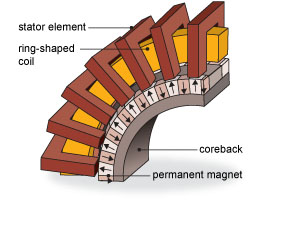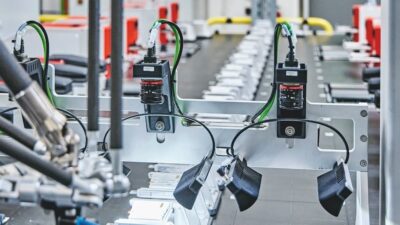Permanent magnets, axial, transverse, and radial flux designs optimize torque, power, efficiency, size, weight, and other motor performance parameters, as explained in this February Control Engineering feature article. Reader feedback added below on Feb. 16.

Electric motors are the mechanical muscle power that drives fans, blowers, pumps, printers, disk drives, ATMs, and industrial and medical machines, along with automobiles, busses, aircraft control surfaces, and hundreds of other applications. Generators who convert mechanical motion into electrical power generation use the same basic rotors, stators, bearings and support structure. Today’s engineering challenges usually include optimizing motor/generator torque, power, efficiency, size, weight, and other performance parameters.
Motor, drive, controls
For electric motors, the specific applications determine the parameters to be optimized. Almost all motors are driven at constant speed, variable speed, or start-stop motion. The increasing emphasis on higher power efficiency leads to variable speed electronic drives being used to achieve higher power efficiency across a wider range than constant speed applications. Developing motion systems that achieve precise positioning capability usually requires motors with high peak torques and smooth velocity and torque motion down to zero speed. The power and control electronics provides a key component to the overall motion control or mechatronics system that includes motor, drive, and control elements.
Five popular generic types of electric motors are the universal brush dc, variable or switched reluctance, ac induction, and electronically controlled brushless synchronous or permanent magnet (PM) synchronous motor. The mature universal motor is a wound field motor that can be driven with ac or dc input voltage. It suffers from lower power efficiency. The brush dc motor in wound field and PM configurations has a limited operating life due to its mechanical commutation system.
New technology developments are primarily limited to the reluctance, induction, and brushless PM synchronous motor systems. More recently, combinations of these three motor technologies have also emerged.
Permanent magnet motor
The permanent magnet electric motor has the highest intrinsic power efficiency and leads the other motor technologies in its wide range of new technology candidates. The brushless permanent magnet synchronous motor (PMSM) has many names, including brushless dc motor, brushless PMAC motor, and electronic controlled motor (ECM).
Today’s PMSMs used in a wide range of applications have their magnets located on the cylindrical rotor surface. The latest new products in the servo positioning world have moved toward buried magnets in cylindrical spoke and interior permanent magnet (IPM) configurations. These buried magnet products incrementally increase torque or reduce size and weight in various precision positioning motion systems. Theses servo motors are finding use in machine tool, robots, and semiconductor equipment.
Axial flux motors
The transportation industry in the form of electric bicycle, scooter, motorcycle, and automobile is the target for new PMSM technology. Two excellent examples of new magnet locations are embodied in the axial flux and transverse flux PMSMs.
The axial flux PMSM (figure) has a unique disk shape that develops more torque than conventional cylindrical-shaped radial flux PMSMs. Its unique configuration fits into the center of drive wheels of most types of vehicles.
Axial flux motor provides high torque and low motor shaft speeds that eliminate the need for expensive gear boxes in many applications. The re-emergence of hybrid or electric driven vehicles has fostered a technical reassessment of axial flux motors for use in traction applications.
There are two major axial flux configurations: the internal PM rotor between two stator windings and the Torus that uses two rotors surrounding the nonmoving stator. The internal PM rotor is its most popular configuration. Transportation companies lead the research efforts along with many treatises created by university professors from around the world in evaluating, designing, and using these motor types. Chinese motor companies are making high volumes of hub axial flux motors for electric bicycles.
Our recent recession killed many of these start-up companies using in hub axial flux motors, but KLD Energy Technologies of Austin, Texas, is providing its 5 kw version axial flux in hub motors to scooter manufacturers. YASA Motors of Abington, UK, has developed its axial flux motors for larger vehicles using a slotless or yokeless stator to produce over 60 Nm (44 lb-ft) @ 3600 rpm (25 kw) and achieve a peak power efficiency of 96%. Almost all axial flux motors use the high-energy Neodymium-Iron-Boron magnets.
A more unique configuration of an axial flux PMSM is the NovaTorque (Sunnyvale, CA) PMSM. This axial flux PMSM has an axial length longer than its radial diameter. The NovaTorque rotor has a pair of conical hub assemblies consisting of ferrite magnets embedded in soft magnetic material in an IPM configuration. This configuration allows the low-cost ferrite magnets to achieve motor performance that matches or exceeds rare earth (Neodymium) magnets.
The rotor hub assemblies are positioned at each end of the rotor, and the motor flux flows straight (parallel to the shaft) through the axially oriented field poles of the stator. The conical-shaped rotor hub surfaces create a larger air gap area and resultant improved torque. NovaTorque’s first product, a 3 hp PMSM axial flux motor under the brand name Premium Plus+, develops 159 lb-in (18 Nm) @ 1800 rpm. NovaTorque’s industry focus is the fans, pumps, and compressors used in heating, ventilation, and air conditioning refrigeration (HVACR) products.
Transverse flux motors
The transverse flux motor possesses a complex magnetic circuit. While both radial flux and axial flux motors can be simulated with two-dimensional FEA and more direct mathematic models, the transverse flux motor requires three-dimensional FEA models due to its three-dimensional (3D) magnetic circuits. A ring-shaped stator winding is surrounded by a number of U-shaped magnetic elements. While the transverse flux motor was invented in 1896 by W.M. Morday, the applications that need its enhanced performance capability are emerging slowly due to its complicated structure and extra cost. The development of Neodymium magnets and soft magnetic composite materials has allowed Landert Motoren of Biilach, Switzerland, to develop a family of smaller transverse flux motors, the MDD1 series, with rated torque ranging from 3.3 Nm to 10 Nm @ 300 rpm (100 watts to 300 watts). Applications include rotary tables and other industrial machines.
South Korea’s Electric Research Institute (KERI) has been building various transverse flux motors for more than 10 years. Its mechatronics group has developed rotary and linear versions. Material transport systems were developed up to 1120 lbs-force (5000 N). The transverse flux motor can achieve a very high torque and power density along with a higher manufacturing cost. Its use is currently limited to special applications.
Hybrid cylindrical motors
The radial flux cylindrical motors are also developing new motor technologies by integrating permanent magnet (PM) with variable reluctance and PM with ac induction motors.
QM Power is the best example of a combination of motor technologies. The new QM Power Parallel Path Magnetic Technology (PPMT) combines VR and PM technology. There are two flux patterns developed and sharing the same motor magnetic elements, one from the two PMs and the other from the VR rotor-stator winding configuration. QM Power reports that magnetic force can typically be tripled resulting in a 30% increase in power density and a similar boost in peak efficiency. It is a scalable from 100 watts to hundreds of kilowatts.
The PPMT is aimed at both constant speed and variable speed applications including traction drives. PPMT retains higher power efficiency in higher load conditions. It can achieve excellent performance with ferrite magnets.
Another example of hybrid motor technology is the line start ac induction motor that combines a squirrel cage rotor with a PM magnet cage (usually ferrite type) to significantly improve the ac motor’s power efficiency. Lafert Corp. of Venice, Italy, has a family of industrial and commercial line start ac motors ranging from 1 kw to 15 kw with peak efficiency ratings boosted by 5% to 8%.
Simulation tools
Many of these “new” motor technologies awaited the development of new drive and control electronics, new magnets, and new insulation materials. New simulation tools aid the design of these new motor technologies.
The need for higher torque density, power density, and energy-efficiency motors and generators matches the need for new hybrid and electric vehicle drive motors, new more efficient generators, and smaller and more efficient smart HVACR products. Product cost versus motor and generator performance must be carefully matched to applications needs.
For more info, see:
www.keri.re.kr/keri/english/main/main.php
www.kldenergy.com
www.novatorque.com
www.oxfordyasamotors.com
Also read:
Cover story: Energy-Efficient Electric Motors
Rise of the PM Machines – Permanent magnet brushless synchronous motors have moved beyond traditional applications with higher efficiency than induction machines.
Browse the Control Engineering Motors and Drives channel.
READER FEEDBACK – COMMENTS
Great article from Dan Jones on new motor technology. Great to get this by email. [This article was included in the Feb. 10 Control Engineering Machine Control monthly eNewsletter. Others may subscribe to eNewsletters at www.controleng.com/subscribe; browse other motor developments at www.controleng.com/new-products/motors-and-drives.html.]
The article cuts across many industries and should be followed up with some details on the individual companies that were cited. [See additional links added below.] I think there is a lot of interest because motors are so widely used and so poorly understood. The connection to the electric car is also a popular theme.
Thanks for a great job.
Steve Meyer, CEO/Senior Consultant
Solid Tech Inc.



